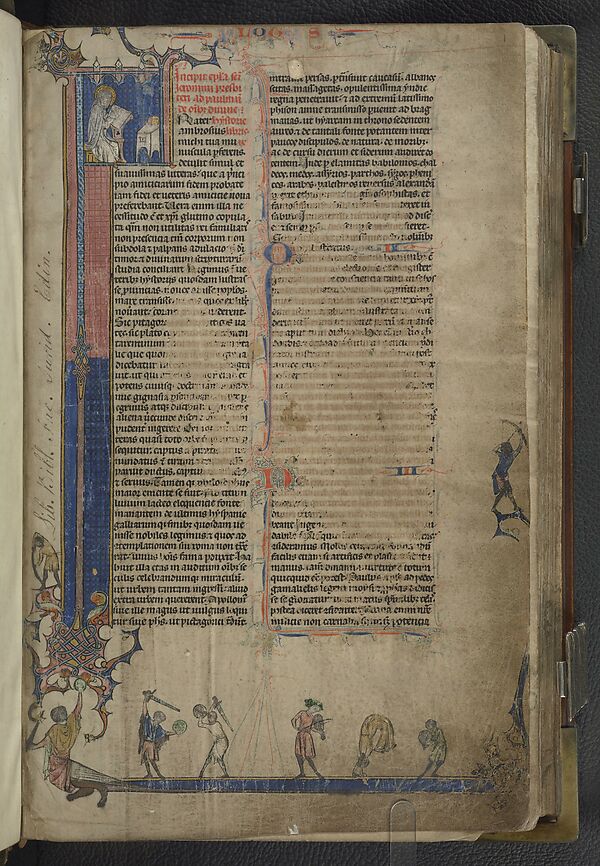Bibles.
Found in 57 Collections and/or Records:
Manuscript, possibly 11th century, of the Gospels of Saints Mark and Luke, and part of the prologue of Saint John.
Microfilm of 13th-century Bible, written in France.
Microfilm of glossed copy of ‘Tabula super bibliam’ by Johannes Vasco, 1393; and, copies, 1623, by John Wither of English rolls of arms, 13th-15th century.
The contents are as follows:
‘Tabula super bibliam’. A glossed copy, early 15th century, of a summary of the Bible in Latin verse by Johannes Vasco, Order of Friars Minor, with the explanatory verses which give the date of composition as 1393 (Adv.MS.18.4.2);
Copies, 1623, by John Wither of English rolls of arms, 13th-15 century, mostly from ‘An auntient booke of Armes which Mr Glover Somerset the Harald had of Mr Joseph Holland in Cullers’ (Adv.MS.31.7.10).
Microfilm of manuscript of the New Testament.
Microfilm of manuscript of the New Testament.
Microfilm of the Codex Edinburgensis, a Hebrew manuscript of the Old Testament.
Microfilm of the Codex Edinburgensis, part I., 10th century.
Microfilm of the Codex Edinburgensis, part II., 10th century.
Mid 13th-century Bible, probably written in England.
Miscellaneous papers of the Oliphants of Gask., 17th century-19th century.
'Newe Testament', a Middle English manuscript of the New Testament, in the earlier version of the Wycliffite Bible, written in England in the late 14th century.
Notes of births and deaths, 1662-1835, of members of a family named Cogan who lived in Ireland, Glasgow and Edinburgh, contained in a volume including printed works, 1633-1639.
The notes are dispersed through the printed texts, which are:
(1) ‘The Holy Bible’ (London, 1638);
(2) ‘A Briefe Concordance’ (London, 1633); and,
(3) ‘The Whole Book of Psalmes’ (London, 1639).
A typed family tree made out from the notes has been pasted inside the front cover.
Old Testament (Edinburgh, 1826) in Gaelic, interleaved and with manuscript amendments and notes, probably for a revised edition of the Gaelic Bible.
Papers of and concerning the Reverend George Murray Reith.
Including notebooks, press cuttings, an unpublished life of Sir Stamford Raffles, and lectures on ecclesiastical history.
Photocopies of six sample pages of annotations on the interleavings of a Bible.
Printed bible, formerly in the possession of the Marquess of Argyll.
The title page is wanting, but the Bible is probably that printed by R Barker, London, 1640 (S.T.C. 2342).
It has marginal notes in the hand of the Marquess of Argyll.
Printed label reading 'A memento of the Secession Church found 1734 at Andrew's Fold Yetts of Muckhart dissolved 1925' and a photograph of the church, pasted to front endpapers of ‘Holy Bible’ (London and Glasgow, [1910])
There is also a manuscript note on the label, 'married 1887', which refers to the Reverend William C Dickson, minister of the church and father of the donor.
Printouts, paper tapes, slides and other papers illustrating the work of Professor George H C MacGregor and Dr Andrew Q Morton on the analysis of Biblical and literary texts by computer.
Receipts to George and Andrew Bathgate., 1759-1775.
The inside of the cover consists of printed sheets from a Bible (Isaiah, chapters 8-13 are visible).

'Ruskin Bible'.
Sermons and papers of John Sime with papers of the Philadelphian Society.
"The Holy Bible" with annotations by and concerning Sir James Y Simpson.
'The Psalms of David' (Oxford)., Undated.
Printed items and photographs of and concerning the novelist and playwright, Annie S Swan (1859-1943). As some of the items are dated later than 1943 they evidently did not belong to Annie S Swan but have been left in the collection. With letter, 1942, of the Earl of Rosebery to V Rule, concerning a social engagement.
